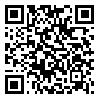BibTeX | RIS | EndNote | Medlars | ProCite | Reference Manager | RefWorks
Send citation to:
URL: http://irje.tums.ac.ir/article-1-5517-en.html
2- Mofid Children`s Hospital Department of Pathology, School of Medicine, Shahid Beheshti University of Medical Sciences, Tehran, Iran
3- School of Medicine, Shahid Beheshti University of Medical Sciences, Tehran, Iran
Background and Objectives: Hirschsprung's disease is one of the congenital movement disorders of the bowel whose accurate and timely diagnosis in childhood is important. The disease occurs due to lack of ganglion cells in the distal part of the digestive system and leads to functional obstruction of the colon. Recently, by the frozen section method, the diagnosis and treatment of the disease is possible through one-stage surgery with fewer complications and lower costs without the need for early colostomy. The aim of this study was to evaluate the validity of frozen section in Hirschsprung's disease.
Methods: this retrospective study was done on 406 frozen section results obtained from patients admitted to Mofid Hospital during 1389-90. We evaluated the frequency of “positive” and “negative” samples and compared them with the results of the permanent section. Moreover, the validity, sensitivity, specificity, and positive and negative predictive value of frozen section were calculated.
Results: After examining 406 frozen section samples and comparison with the results of permanent section, the results were consistent for both methods in 369 cases (90.89%) while the results were inconsistent in 37 cases (9.11%). Frozen section showed 7 (1.7%) false negative and 30 false positive (7.3%) cases. The sensitivity, specificity, positive predictive value, and negative predictive value of frozen section was 94.44%, 89.29%, 79.87%, and 97.28%, respectively.
Conclusion: Frozen section is a good tool for screening and diagnosis. Its power to rule out the disease is rather more than its power to confirm its presence. so it is capable of ruling out the disease in 97% and confirming its presence in 80% of the cases.
Received: 2016/08/7 | Accepted: 2016/08/7 | Published: 2016/08/7
| Rights and permissions | |
 |
This work is licensed under a Creative Commons Attribution-NonCommercial 4.0 International License. |





